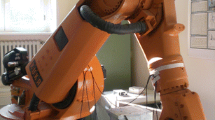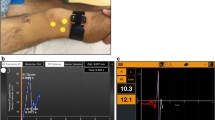Abstract
Purpose
Concomitant meniscus injuries in the anterior cruciate ligament (ACL) have been suggested to exacerbate rotational laxity. However, the effect is supposed to be so small, if any, that some quantitative pivot-shift measurement is needed. The purpose of this prospective study was to determine the effect of meniscus tear on rotational laxity in ACL-deficient knees by an quantitative measurement. It was hypothesized that a concomitant meniscus tear, especially a lateral one, would induce greater pivot shift.
Methods
Fifty-seven unilateral ACL-injured patients (26 men and 31 women, mean age: 24 ± 10 years) were included. The pivot-shift test was performed prior to ACL reconstruction, while a quantitative evaluation using an electromagnetic system to determine tibial acceleration and a clinical grading according to the IKDC were performed. Meniscus injuries were diagnosed arthroscopically, and concomitant meniscus tear was confirmed in 32 knees.
Results
The clinical grade was not different between the ACL-injured knees of patients with and without meniscus tear (n.s.). Tibial acceleration did not show a statistical significant difference (meniscus-injured knees: 1.6 ± 1.1 m/s2 versus meniscus-intact knees: 1.2 ± 0.7 m/s2, n.s.). However, the subgroup analysis demonstrated that there was increased tibial acceleration in ACL-deficient knees with lateral meniscus tear (2.1 ± 1.1 m/s2, n = 13) compared with meniscus-intact knees (p < 0.05), whereas rotational laxity did not increase in the medial meniscus-injured and bilateral-injured knees (1.2 ± 0.9 m/s2, n = 12, n.s. and 1.4 ± 1.1 m/s2, n = 7, n.s., respectively).
Conclusion
A concomitant meniscus tear, especially a lateral meniscus tear, has a significant impact on rotational laxity in ACL-injured knees. When a large pivot shift is observed in the ACL-injured knee, a concomitant meniscus tear should be suspected and an aggressive treatment would be considered. Meniscus injuries should be inspected carefully when substantial pivot shift is encountered in ACL-injured knees.
Level of evidence
Diagnostic study, Level III.

Similar content being viewed by others
References
Ahlden M, Araujo P, Hoshino Y, Samuelsson K, Middleton KK, Nagamune K et al (2012) Clinical grading of the pivot shift test correlates best with tibial acceleration. Knee Surg Sports Traumatol Arthrosc 20(4):708–712
Ahn JH, Bae TS, Kang KS, Kang SY, Lee SH (2011) Longitudinal tear of the medial meniscus posterior horn in the anterior cruciate ligament-deficient knee significantly influences anterior stability. Am J Sports Med 39(10):2187–2193
Araki D, Kuroda R, Matsushita T, Kuroda R, Matsushita T, Matsumoto T et al (2013) Biomechanical analysis of the knee with partial anterior cruciate ligament disruption: quantitative evaluation using an electromagnetic measurement system. Arthroscopy 29(6):1053–1062
Bedi A, Musahl V, Lane C, Citak M, Warren RF, Pearle AD (2010) Lateral compartment translation predicts the grade of pivot shift: a cadaveric and clinical analysis. Knee Surg Sports Traumatol Arthrosc 18(9):1269–1276
Claes S, Vereecke E, Maes M, Victor J, Verdonk P, Bellemans J (2013) Anatomy of the anterolateral ligament of the knee. J Anat 223(4):321–328
Desai N, Bjornsson H, Musahl V, Bjornsson H, Musahl V, Bhandari M et al (2014) Anatomic single- versus double-bundle ACL reconstruction: a meta-analysis. Knee Surg Sports Traumatol Arthrosc 22(5):1009–1023
Dodds AL, Halewood C, Gupte CM, Williams A, Amis AA (2014) The anterolateral ligament: anatomy, length changes and association with the Segond fracture. Bone Joint J 96-B(3):325–331
Fetto JF, Marshall JL (1979) Injury to the anterior cruciate ligament producing the pivot-shift sign. J Bone Joint Surg Am 61(5):710–714
Granan LP, Forssblad M, Lind M, Engebretsen L (2009) The Scandinavian ACL registries 2004–2007: baseline epidemiology. Acta Orthop 80(5):563–567
Grood ES, Suntay WJ (1983) A joint coordinate system for the clinical description of three-dimensional motions: application to the knee. J Biomech Eng 105(2):136–144
Hoshino Y, Araujo P, Ahlden M, Moore CG, Kuroda R, Zaffagnini S et al (2012) Standardized pivot shift test improves measurement accuracy. Knee Surg Sports Traumatol Arthrosc 20(4):732–736
Hoshino Y, Araujo P, Ahldén M, Samuelsson K, Muller B et al (2013) Quantitative evaluation of the pivot shift by image analysis using the iPad. Knee Surg Sports Traumatol Arthrosc 21(4):975–980
Hoshino Y, Kuroda R, Nagamune K, Yagi M, Mizuno K, Yamaguchi M et al (2007) In vivo measurement of the pivot-shift test in the anterior cruciate ligament-deficient knee using an electromagnetic device. Am J Sports Med 35(7):1098–1104
Irrgang JJ, Ho H, Harner CD, Fu FH (1998) Use of the International Knee Documentation Committee guidelines to assess outcome following anterior cruciate ligament reconstruction. Knee Surg Sports Traumatol Arthrosc 6(2):107–114
Kittl C, El-Daou H, Athwal KK, Gupte CM, Weiler A, Williams A et al (2016) The role of the anterolateral structures and the ACL in controlling laxity of the intact and ACL-deficient knee: response. Am J Sports Med 44(2):345–354
Krych AJ, Wu IT, Desai VS, Murthy NS, Collins MS, Saris DBF et al (2018) High rate of missed lateral meniscus posterior root tears on preoperative magnetic resonance imaging. Orthop J Sports Med 9(4):2325967118765722 6(
Kuroda R, Hoshino Y, Kubo S, Araki D, Oka S, Nagamune K et al (2012) Similarities and differences of diagnostic manual tests for anterior cruciate ligament insufficiency: a global survey and kinematics assessment. Am J Sports Med 40(1):91–99
Labbe DR, de Guise JA, Mezghani N, de Guise JA, Mezghani N, Godbout V et al (2010) Feature selection using a principal component analysis of the kinematics of the pivot shift phenomenon. J Biomech 43(16):3080–3084
Lopomo N, Signorelli C, Bonanzinga T, Marcheggiani Muccioli GM, Visani A, Zaffagnini S (2012) Quantitative assessment of pivot-shift using inertial sensors. Knee Surg Sports Traumatol Arthrosc 20(4):713–717
Lorbach O, Kieb M, Herbort M, Weyers I, Raschke M, Engelhardt M (2015) The influence of the medial meniscus in different conditions on anterior tibial translation in the anterior cruciate deficient knee. Int Orthop 39(4):681–687
Lording T, Corbo G, Bryant D, Burkhart TA, Getgood A (2017) Rotational laxity control by the anterolateral ligament and the lateral meniscus is dependent on knee flexion angle: a cadaveric biomechanical study. Clin Orthop Relat Res 475(10):2401–2408
Maeyama A, Hoshino Y, Debandi A, Kato Y, Saeki K, Asai S et al (2011) Evaluation of rotational instability in the anterior cruciate ligament deficient knee using triaxial accelerometer: a biomechanical model in porcine knees. Knee Surg Sports Traumatol Arthrosc 19(8):1233–1238
Magnussen RA, Reinke EK, Huston LJ, Group MOON, Hewett TE, Spindler KP (2016) Factors associated with high-grade Lachman, pivot-shift, and anterior drawer at the time of ACL reconstruction. Arthroscopy 32(6):1080–1085
Maletis GB, Granan LP, Inacio MC, Funahashi TT, Engebretsen L (2011) Comparison of community-based ACL reconstruction registries in the U.S. and Norway. J Bone Joint Surg Am 93(Suppl 3):31–36
Matsumoto H (1990) Mechanism of the pivot shift. J Bone Joint Surg Br 72(5):816–821
Musahl V, Getgood A, Neyret P, Claes S, Burnham JM, Batailler C et al (2017) Contributions of the anterolateral complex and the anterolateral ligament to rotatory knee stability in the setting of ACL injury: a roundtable discussion. Knee Surg Sports Traumatol Arthrosc 25(4):997–1008
Musahl V, Citak M, O’Loughlin PF, Choi D, Bedi A, Pearle AD (2010) The effect of medial versus lateral meniscectomy on the stability of the anterior cruciate ligament-deficient knee. Am J Sports Med 38(8):1591–1597
Musahl V, Rahnemai-Azar AA, Costello J, Arner JW, Fu FH, Hoshino Y et al (2016) The influence of meniscal and anterolateral capsular injury on knee laxity in patients with anterior cruciate ligament injuries. Am J Sports Med 44(12):3126–3131
Musahl V, Hoshino Y, Ahlden M, Araujo P, Irrgang JJ, Zaffagnini S et al (2012) The pivot shift: a global user guide. Knee Surg Sports Traumatol Arthrosc 20(4):724–731
Nagai K, Araki D, Matsushita T, Nishizawa Y, Hoshino Y, Matsumoto T et al (2016) Biomechanical function of anterior cruciate ligament remnants: quantitative measurement with a 3-dimensional electromagnetic measurement system. Arthroscopy 32(7):1359–1366
Nagai K, Hoshino Y, Nishizawa Y, Araki D, Matsushita T, Matsumoto T et al (2015) Quantitative comparison of the pivot shift test results before and after anterior cruciate ligament reconstruction by using the three-dimensional electromagnetic measurement system. Knee Surg Sports Traumatol Arthrosc 23(10):2876–2881
Noyes FR, Grood ES, Cummings JF, Wroble RR (1991) An analysis of the pivot shift phenomenon. The knee motions and subluxations induced by different examiners. Am J Sports Med 19(2):148–155
Noyes FR, Huser LE, Levy MS (2017) Rotational knee instability in ACL-deficient knees: role of the anterolateral ligament and iliotibial band as defined by tibiofemoral compartment translations and rotations. J Bone Joint Surg Am 99(4):305–314
Peeler J, Leiter J, MacDonald P (2010) Accuracy and reliability of anterior cruciate ligament clinical examination in a multidisciplinary sports medicine setting. Clin J Sport Med 20(2):80–85
Rotterud JH, Sivertsen EA, Forssblad M, Engebretsen L, Aroen A (2013) Effect of meniscal and focal cartilage lesions on patient-reported outcome after anterior cruciate ligament reconstruction: a nationwide cohort study from Norway and Sweden of 8476 patients with 2-year follow-up. Am J Sports Med 41(3):535–543
Shybut TB, Vega CE, Haddad J, Alexander JW, Gold JE, Noble PC et al (2015) Effect of lateral meniscal root tear on the stability of the anterior cruciate ligament-deficient knee. Am J Sports Med 43(4):905–911
Slauterbeck JR, Kousa P, Clifton BC, Naud S, Tourville TW, Johnson RJ et al (2009) Geographic mapping of meniscus and cartilage lesions associated with anterior cruciate ligament injuries. J Bone Joint Surg Am 91(9):2094–2103
Tanaka M, Vyas D, Moloney G, Bedi A, Pearle AD, Musahl V (2012) What does it take to have a high-grade pivot shift? Knee Surg Sports Traumatol Arthrosc 20(4):737–742
Tanaka T, Hoshino Y, Miyaji N, Ibaragi K, Nishida K, Nishizawa Y et al (2018) The diagnostic reliability of the quantitative pivot-shift evaluation using an electromagnetic measurement system for anterior cruciate ligament deficiency was superior to those of the accelerometer and iPad image analysis. Knee Surg Sports Traumatol Arthrosc 26(9):2835–2840
Vincent JP, Magnussen RA, Gezmez F, Magnussen RA, Gezmez F, Uguen A et al (2012) The anterolateral ligament of the human knee: an anatomic and histologic study. Knee Surg Sports Traumatol Arthrosc 20(1):147–152
Zaffagnini S, Signorelli C, Bonanzinga T, Grassi A, Galan H, Akkawi I et al (2016) Does meniscus removal affect ACL-deficient knee laxity? An in vivo study. Knee Surg Sports Traumatol Arthrosc 24(11):3599–3604
Funding
This study was supported by JSPS KAKENHI Grant Number JP16K10902.
Author information
Authors and Affiliations
Contributions
All authors have made substantial contributions to (1) the conception and design of the study, or acquisition, analysis and interpretation of data; (2) drafting the article or revising it critically for important intellectual content; (3) final approval of the version to be submitted; and (4) agreement to be accountable for all aspects of the work in ensuring that questions related to the accuracy or integrity of any part of the work are appropriately resolved. The specific contributions of the authors are as follows: (1) Conception and design of the work; YH, NM, TM, RK. (2) Acquisition, analysis, and interpretation of data for the work: YH, NM, KN, YN, DA, TM. (3) Drafting the article: YH, NM. (4) Critical revision of the article for important intellectual content: YH, NM, KN, KK, TM, RK. (5) Final approval of the version to be published: YH, NM, KN, YN, DA, NK, KK, TM, RK. (6) Agreement to be accountable for all aspects of the work in ensuring that questions related to the accuracy or integrity of any part of the work are appropriately investigated and resolved: YH, MK, RK.
Corresponding author
Ethics declarations
Conflict of interest
The authors report that they have no conflicts of interest in the authorship and publication of this article.
Ethical approval
The Ethics Committee of Kobe University Graduate School of Medicine approved this study.
Rights and permissions
About this article
Cite this article
Hoshino, Y., Miyaji, N., Nishida, K. et al. The concomitant lateral meniscus injury increased the pivot shift in the anterior cruciate ligament-injured knee. Knee Surg Sports Traumatol Arthrosc 27, 646–651 (2019). https://doi.org/10.1007/s00167-018-5209-7
Received:
Accepted:
Published:
Issue Date:
DOI: https://doi.org/10.1007/s00167-018-5209-7




